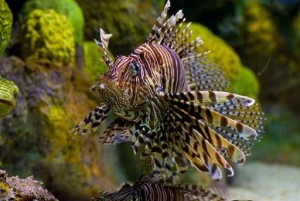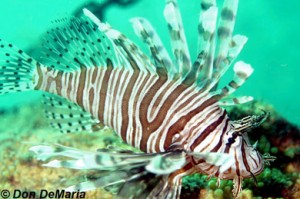The Red Lionfish, Pterois volitans, Smithsonian is a poisonous tropical fish native to southeast Asia. The fish is invading the Atlantic from Florida and the Bahamas to Rhode Island, and wreaking ecological havoc. The big problems with non-native species are a lack of natural predators and a lack of natural defense on the part of the prey.

- Image courtesy of New England Acquarium, neaq.org, Used with permission.
Sharks, Groupers and other predators keep the populations in check in south-east Asia. Red Sea Cornetfish (Fistularia commersoni) are natural predators of Pterois miles, a related species of scorpaenidaea. Importing south-east Asian sharks or red sea cornetfish would probably be a stupid idea, one where the cure may be worse than the disease. I wonder, however, if we can train dolphins or sea lions to hunt or trap the Red Lionfish?
Scientists think that the invasion can be traced to Hurricane Andrew, in 1992, when a saltwater fish facility in Biscayne Bay, Florida was destroyed during the storm, and a total of SIX Red Lionfish were accidentally released into the Atlantic Ocean. At least two of these fish survived. They formed a colony on the Florida coast, spread east to the Bahamas, and and has been spreading north, as their eggs float with the currents. As many as five hundred have already been collected on the south shore of Long Island.
The invasion of an ecosystem by foreign flora or fauna generally wreaks eco-havoc because the invading species has no natural predators, and its prey has no natural defenses. The Red Lionfish is a textbook case. More information can be found at the Florida Museum of Natural History the Smithsonian Marine Station at Fort Pierce, and the Florida Museum of Natural History.
The fish are fierce predators. Unlike most fish, which will flee when approached by a larger animal, the Lionfish instead turns and faces its attacker, dips its head downward and flairs out all its fin rays. This behavior is also used to capture its prey. The favorite food are shrimp and smaller fish. The Red Lionfish will slowly follow and stalk its prey until it has it cornered against a rock and then, amazingly, will surround the smaller animal with all of its long pectoral rays, leaving, in the victim’s view, no escape.
Because the fish cannot withstand temperatures below 10 C (about 50 F) they can’t overwinter north of the Carolinas. However because the eggs float with the currents, they can travel north, hatch, and because they are voracious predators they can wreak havoc during their shortened lifespan.

- Copyright (c) Don DeMaria. Used with Permission.